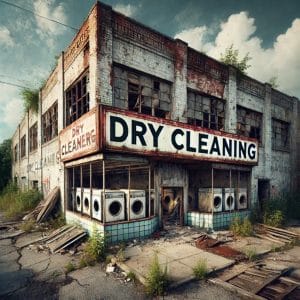 Contributed by Trey Hess P.E., Director of Brownfields and Economic Development, PPM Consultants
Contributed by Trey Hess P.E., Director of Brownfields and Economic Development, PPM Consultants
Following up on my article entitled “COVID and Dry Cleaners: Where are Things Headed,” I thought I would share some further insight related to the complex nature of commercial real estate transactions related to current and former dry-cleaning operations. Dry cleaning operations, widely known for their use of harmful chemicals, pose significant health and environmental risks. Perchloroethylene (PCE), also known as “perc,” is a key chemical solvent used in the dry-cleaning process. Due to its high toxicity, PCE exposure can cause various health issues, ranging from dizziness, headaches, and nausea to severe long-term effects such as liver damage and cancer.
Regulatory Framework
 To mitigate the potential risks associated with PCE and other chemicals, the U.S. Environmental Protection Firm (EPA) has implemented regulations and guidelines. Three key regulations include the Resource Conservation and Recovery Act (RCRA), the Clean Air Act, and the Comprehensive Environmental Response, Compensation, and Liability Act (CERCLA), commonly known as the Superfund law:
To mitigate the potential risks associated with PCE and other chemicals, the U.S. Environmental Protection Firm (EPA) has implemented regulations and guidelines. Three key regulations include the Resource Conservation and Recovery Act (RCRA), the Clean Air Act, and the Comprehensive Environmental Response, Compensation, and Liability Act (CERCLA), commonly known as the Superfund law:
- Resource Conservation and Recovery Act (RCRA)
- Hazardous Waste Management: RCRA mandates that dry cleaners properly store, transport, and dispose of their hazardous waste. This includes correct labeling of waste containers and secure storage to prevent spills and leaks. Additionally, waste transportation must comply with state and federal regulations.
- Clean Air Act
- Emission Control: The Clean Air Act addresses the emissions of volatile organic compounds (VOCs) from dry-cleaning operations. VOCs, major components of dry-cleaning solvents, contribute to air pollution problems like smog formation. The Act requires dry cleaners to employ equipment and practices that minimize VOC emissions.
- Superfund Law (CERCLA):
- Assessment and Cleanup: PCE and the family of daughter compounds associated with dry cleaning are considered hazardous substances under CERCLA. This designation allows the EPA to require responsible parties to report releases and undertake or fund cleanup activities. It also facilitates faster cleanup of contaminated sites and ensures that polluters, rather than taxpayers, bear the cleanup costs.
PFAS in Dry Cleaning?
In 2019, the Florida Department of Environmental Protection’s (FDEP) Waste Cleanup Program undertook a comprehensive statewide survey involving 15 dry-cleaning facilities eligible for state-funded cleanup. The primary goal was to ascertain whether Per-and polyfluoroalkyl substances (PFAS) could be contaminants of concern within these facilities. Although PFAS are not typically associated with the dry-cleaning industry, there exists a potential for these substances to be present in waste streams resulting from the cleaning or laundering of fabrics.
PFAS, specifically Perfluorooctanoic acid (PFOA) and Perfluorooctane sulfonic acid (PFOS), are among the most recognized and studied chemicals within this group. PFOA and PFOS are synthetic compounds, first developed in the 1940s, known for their persistence in the environment and resistance to degradation. These chemicals have been widely used in numerous commercial products, including stain and water repellents in textiles and fire suppression foams. The survey conducted by the FDEP revealed that PFAS can indeed be associated with the waste streams of dry-cleaning facilities. This association raises significant concerns, as PFAS contamination in the environment can lead to serious health and ecological risks due to their persistence and potential toxicity. The survey included sampling and analysis of waste streams at 15 dry-cleaning facilities across Florida. The results indicated that PFAS contamination was present at several sites, sometimes exceeding the provisional cleanup standards established by FDEP at that time. Where contamination levels were found to be above these thresholds, DEP coordinated with the Florida Department of Health to assess nearby water supply wells. This included conducting sampling of drinking water wells to ensure that human health was not at risk. The State of Michigan looked further into it analyzing the impact of PFAS, focusing primarily on testing results from numerous publicly owned treatment works (POTWs) across the state. The 2021-2022 results indicated varying trace levels of PFAS in the water supplies of each POTW. A positive takeaway for dry cleaning operators from this data is that laundries contributed a relatively small portion of PFAS waste at approximately 5%. In April 2024, the EPA finalized a rule establishing the first-ever national drinking water standards for six PFAS, including PFOA, PFOS, PFHxS, PFNA, and HFPO-DA, also known as “GenX chemicals.” This rule sets Maximum Contaminant Levels (MCLs) and mandates public water systems to monitor, report, and reduce PFAS levels in drinking water supplies (US EPA) (US EPA). States are now weighing the consequences of adopting the EPA MCLs into their own State Cleanup Programs.
Transition to Environmentally Friendly Practices
Over the last decade or two, there has been a shift towards more environmentally friendly dry-cleaning practices:
- Alternative Solvents: Some dry cleaners are now using less toxic solvents, such as liquid carbon dioxide or hydrocarbon, instead of PCE.
- Solvent Recycling: Other dry cleaners have adopted equipment that recycles solvents, thereby reducing the volume of hazardous waste generated.
Conclusion
The EPA and State regulators recognize the significant environmental and health risks associated with dry cleaning operations and are actively working to ensure these risks are managed and regulated. The Superfund and State cleanup programs play vital roles in addressing contaminated sites, but prevention through safer cleaning practices and proper hazardous waste management is the most effective strategy. If contamination is identified in a release to the environment, a good strategy is to evaluate the business, health, and environmental risks associated with the contamination. Many states have established assessment and cleanup criteria for the purpose of determining, on a site-specific basis, the rehabilitation program tasks that comprise a site rehabilitation program and the level at which a rehabilitation program task and a site rehabilitation program may be deemed completed. These rules incorporate to the maximum extent feasible, risk-based corrective action principles to achieve protection of human health and safety and the environment in a cost-effective manner. These principles can be complex, and each state cleanup program is unique. Having an environmental consultant, like PPM Consultants, to “simplify the complex,” is the first step in assisting you with your permitting, compliance, assessment, and cleanup strategy.

